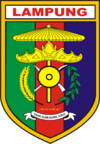Sabtu, 29 Juni 2013
Lampung Province
| Lampung | |||
|---|---|---|---|
| — Province — | |||
| Mount Krakatoa, Lampung Province | |||
|
|||
| Motto: "Sai Bumi Ruwa Jurai" | |||
| Location of Lampung in Indonesia | |||
| Coordinates: 5°27′S 105°16′ECoordinates: 5°27′S 105°16′E | |||
| Country | Indonesia | ||
| Capital | Bandar Lampung | ||
| Government | |||
| • Governor | Sjachroedin ZP | ||
| Area | |||
| • Total | 34,623.80 km2 (13,368.32 sq mi) | ||
| Population (2010)[1] | |||
| • Total | 7,596,115 | ||
| • Density | 220/km2 (570/sq mi) | ||
| Demographics | |||
| • Ethnic groups | Javanese (62%), Sundanese (9%), Lampung (10%), Malay (4%), Bantenese (3%) [2] | ||
| • Religion | Muslim (92%), Protestant (1.8%), Catholic (1.8%), Buddhist (1.7%) | ||
| • Languages | Indonesian | ||
| Time zone | WIB (UTC+7) | ||
| Website | lampungprov.go.id | ||
The province had a population of 7,596,115 at the 2010 census.[1] Three quarters of the current population of Lampung is descended from migrants from Java, Madura, and Bali. These migrants came on their initiative, in search of more land than was available on the more densely populated islands, and as part of the national government's transmigration program, for which Lampung was one of the earliest and most significant transmigration destinations.
Lampung is commonly known for its geographical instability in terms of earthquakes and volcanoes. On 10 May 2005, an earthquake measuring 6.4 on the Richter scale struck the province. The historical volcano blast of Krakatau which occurred in 1883, had disastrous consequences.
History
The area was part of the Banten Sultanate until it was annexed by the Dutch in 1752 and then became known as Residentie Lampoengse Districten.[3] It was part of the Dutch East Indies.Administration
Lampung Province is subdivided into twelve regencies and two autonomous cities, listed below with their (provisional) populations at the 2010 Census. In addition, West Pesisir Regency was formed on October 25, 2012 from West Lampung Regency.| Name | Area (km2) | Population Estimate 2005 |
Population Census 2010 |
Capital |
|---|---|---|---|---|
| Bandar Lampung (city) | 118.50 | 790,057 | 879,651 | Bandar Lampung |
| Metro (city) | 68.74 | 127,569 | 145,346 | Metro |
| West Lampung Regency (Lampung Barat) |
4,950.40 | 377,875 | 418,560 | Liwa |
| Tanggamus Regency | 3,356.61 | 821,119 | 534,595 | Kota Agung |
| South Lampung Regency (Lampung Selatan) |
2,109.74 | 1,278,647 | 909,989 | Kalianda |
| East Lampung Regency (Lampung Timur) |
5,325.03 | 919,125 | 950,574 | Sukadana |
| North Lampung Regency (Lampung Utara) |
2,725.63 | 554,136 | 583,925 | Kotabumi |
| Central Lampung Regency (Lampung Tengah) |
4,789.80 | 1,126,232 | 1,170,048 | Gunung Sugih |
| Way Kanan Regency | 3,921.63 | 359,912 | 406,735 | Blambangan Umpu |
| Tulang Bawang Regency | 6,851.32 | 749,900 | 397,079 | Menggala |
| Pesawaran Regency | 2,243.51 | 397,294 | Gedong Tataan | |
| Pringsewu Regency | 625.00 | 364,825 | Pringsewu | |
| Mesuji Regency | 432.60 | 187,286 | Mesuji | |
| West Tulang Bawang Regency (Tulang Bawang Barat) |
1,201.00 | 250,208 | Panaragan Jaya | |
| Total Province | 34,623.80 | 7,104,572 | 7,596,115 | Bandar Lampung |
Textile

A couple from Lampung in traditional costume during colonial period.
The oldest surviving examples of Lampung textiles date back to the eighteenth century,[citation needed] but some scholars believe that weaving may date back to the first millennium AD when Sumatra first came under Indian cultural influence.[who?] The prevalence of Buddhist motifs, such as diamonds, suggests that the weaving traditions were already active in the time when Lampung came under the Buddhist Srivijayan rule. There are similarities between Lampung weaving and weaving traditions in some parts of modern-day Thailand that experienced cultural contact with Sriwijaya.
Lampung textiles, Palepai, tatebin and tampan were called 'ship cloths' because ships are a common motif.[6] The ship motif represents the transition from one realm of life to the next, for instances from boyhood to manhood or from being single to married and also represents the final transition to the afterlife.[5]
Traditionally, Lampung textiles were used as part of religious ceremonies such as weddings and circumcisions. For instance, the Palepai cloths were used as long ceremonial wall-hangings behind the bridal party in aristocratic marriages. The smaller, more humble tampan cloths were exchanged between families at the time of weddings.
Production of many fine cloths blossomed in the late nineteenth century as Lampung grew rich on pepper production, but the devastating eruption of Krakatoa in 1883 destroyed many weaving villages in the Kalianda area.[7] By the 1920s the increasing importance of Islam and the collapse of the pepper trade brought production to a halt [8] Today Lampung textiles are highly prized by collectors.
Railroads
A 270 kilometer long rail track is planned from Tanjung Enim to Lampung. This rail track would be used for coal transportation to boost coal exports.[9]Tourism
Tourism is not Lampung Province's main income, although the administration will boost tourism by organising a tourism event, Flamboyant Tanjung Setia, to draw tourists visit to Tanjung Setia Beach which has natural panoramic view and challenging waves for surfing. In 2010, there were 400,000 tourists who visited Lampung Province, including 10,000 foreign tourists who mainly came from Australia and New Zealand.[10]
Langganan:
Posting Komentar (Atom)
Chat Chit Chut
ABA Sore
Postingan Gue
Etiquetas
- For Knowlegde (3)
About Me
- Unknown
My Jae Hee

Pengunjung
My Calender
Info Lowongan Kerja (Karir) Lampung Terbaru
Free download mp3 lagu indonesia terbaru gratis lirik lagu musik
Translate







0 komentar:
Posting Komentar